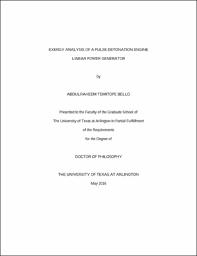
ATTENTION: The works hosted here are being migrated to a new repository that will consolidate resources, improve discoverability, and better show UTA's research impact on the global community. We will update authors as the migration progresses. Please see MavMatrix for more information.
Show simple item record
| dc.contributor.advisor | Lu, Frank | |
| dc.creator | Bello, Raheem Temitope | |
| dc.date.accessioned | 2016-07-22T19:21:40Z | |
| dc.date.available | 2016-07-22T19:21:40Z | |
| dc.date.created | 2016-05 | |
| dc.date.issued | 2016-05-11 | |
| dc.date.submitted | May 2016 | |
| dc.identifier.uri | http://hdl.handle.net/10106/25835 | |
| dc.description.abstract | The fuel efficiency of a power generator is a key metric for evaluating its performance. The common engineering practice is to determine the thermal efficiency of the system by applying the conservation of energy also known as the first law of thermodynamics. However, for heat engine power generators, and other thermal systems, the thermal efficiency is not sufficient for detailed system performance analysis. Exergy analysis, which applies both the first and second law of thermodynamics, enables the determination of the directionality of thermal processes, and the system’s available work. This more complete thermodynamic analysis approach is applied to a pulse detonation engine coupled to a linear power generator which is abbreviated as PDE-LPG.
Analytical and experimental studies of a pulse detonation engine (PDE) were performed focused on power generation. Analytical studies include the development of a one-dimensional model based on the wave processes in a cycle of the PDE, to elucidate its performance during operation in the fully- and partially-filled mode. A novel thermodynamic cycle is developed to describe the operation and performance of the PDE-LPG. The energy and exergy efficiency of the proposed PDE-LPG cycle is compared to the efficiencies of the Brayton, Otto, Diesel, and ZND cycles.
An experimental facility was developed to demonstrate the operation of a PDE with a linear power generator. A diverging nozzle and a piston-spring system were designed and installed at the PDE exit to accelerate the exhaust products, and to improve the transmission of gas momentum to the generator. These components were integrated to produce electrical power. The results of the PDE’s specific impulse, nozzle performance, and generator current and voltage were measured. The chemical, thermal, mechanical, and electrical energy across each subcomponent was measured, and the energy and exergy efficiencies of the experimental PDE-LPG facility are presented. | |
| dc.format.mimetype | application/pdf | |
| dc.language.iso | en_US | |
| dc.subject | Exergy | |
| dc.subject | Detonation | |
| dc.subject | Linear power generator | |
| dc.subject | Thermodynamics | |
| dc.title | Exergy Analysis of a Pulse Detonation Engine Linear Power Generator | |
| dc.type | Thesis | |
| dc.degree.department | Mechanical and Aerospace Engineering | |
| dc.degree.name | Doctor of Philosophy in Aerospace Engineering | |
| dc.date.updated | 2016-07-22T19:21:41Z | |
| thesis.degree.department | Mechanical and Aerospace Engineering | |
| thesis.degree.grantor | The University of Texas at Arlington | |
| thesis.degree.level | Doctoral | |
| thesis.degree.name | Doctor of Philosophy in Aerospace Engineering | |
| dc.type.material | text | |
| local.embargo.terms | 2018-05-01 | |
| local.embargo.lift | 2018-05-01 | |
Files in this item
- Name:
- BELLO-DISSERTATION-2016.pdf
- Size:
- 3.718Mb
- Format:
- PDF
This item appears in the following Collection(s)
Show simple item record


